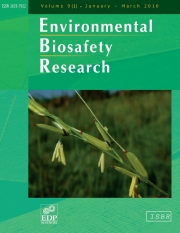Crossref Citations
This article has been cited by the following publications. This list is generated based on data provided by
Crossref.
Lu, Bao-Rong
2003.
Editorial. Transgene containment by molecular means - is it possible and cost effective?.
Environmental Biosafety Research,
Vol. 2,
Issue. 1,
p.
3.
Letourneau, Deborah K.
Robinson, Gaden S.
and
Hagen, Joy A.
2003.
Btcrops: Predicting effects of escaped transgenes on the fitness of wild plants and their herbivores.
Environmental Biosafety Research,
Vol. 2,
Issue. 4,
p.
219.
Gepts, Paul
and
Papa, Roberto
2003.
Possible effects of (trans)gene flow from crops on the genetic diversity from landraces and wild relatives.
Environmental Biosafety Research,
Vol. 2,
Issue. 2,
p.
89.
Devos, Yann
Reheul, Dirk
Schrijver, Adinda DE
Cors, François
and
Moens, William
2004.
Management of herbicide-tolerant oilseed rape in Europe: a case study on minimizing vertical gene flow.
Environmental Biosafety Research,
Vol. 3,
Issue. 3,
p.
135.
Fuchs, Marc
Chirco, Ellen M.
and
Gonsalves, Dennis
2004.
Movement of coat protein genes from a commercial virus-resistant transgenic squash into a wild relative.
Environmental Biosafety Research,
Vol. 3,
Issue. 1,
p.
5.
Prieto, J. L.
Pouilly, N.
Jenczewski, E.
Deragon, J. M.
and
Chèvre, A. M.
2005.
Development of crop-specific transposable element (SINE) markers for studying gene flow from oilseed rape to wild radish.
Theoretical and Applied Genetics,
Vol. 111,
Issue. 3,
p.
446.
Gressel, Jonathan
and
Al-Ahmad, Hani
2005.
Crop Ferality and Volunteerism.
p.
371.
Gaskin, John F.
and
Kazmer, David J.
2006.
Comparison of ornamental and wild saltcedar (Tamarix spp.) along Eastern Montana, USA riverways using chloroplast and nuclear DNA sequence markers.
Wetlands,
Vol. 26,
Issue. 4,
p.
939.
Van De Wiel, C.C.M.
and
Lotz, L.A.P.
2006.
Outcrossing and coexistence of genetically modified with (genetically) unmodified crops: a case study of the situation in the Netherlands.
NJAS: Wageningen Journal of Life Sciences,
Vol. 54,
Issue. 1,
p.
17.
Watanabe, Shin
Sano, Tsunenori
Kamada, Hiroshi
and
Ezura, Hiroshi
2006.
Efficacy of a special screened greenhouse covered by duplex fine mesh in reducing maize outcrossing.
Plant Biotechnology,
Vol. 23,
Issue. 4,
p.
387.
REICHMAN, JAY R.
WATRUD, LIDIA S.
LEE, E. HENRY
BURDICK, CONNIE A.
BOLLMAN, MIKE A.
STORM, MARJORIE J.
KING, GEORGE A.
and
MALLORY‐SMITH, CAROL
2006.
Establishment of transgenic herbicide‐resistant creeping bentgrass (Agrostis stolonifera L.) in nonagronomic habitats.
Molecular Ecology,
Vol. 15,
Issue. 13,
p.
4243.
Chèvre, A. M.
Adamczyk, K.
Eber, F.
Huteau, V.
Coriton, O.
Letanneur, J. C.
Laredo, C.
Jenczewski, E.
and
Monod, H.
2006.
Modelling gene flow between oilseed rape and wild radish. I. Evolution of chromosome structure.
Theoretical and Applied Genetics,
Vol. 114,
Issue. 2,
p.
209.
Reuter, Hauke
Menzel, Gertrud
Pehlke, Hendrik
and
Breckling, Broder
2008.
Hazard mitigation or mitigation hazard?.
Environmental Science and Pollution Research,
Vol. 15,
Issue. 7,
p.
529.
Chandler, Stephen
and
Dunwell, Jim M.
2008.
Gene Flow, Risk Assessment and the Environmental Release of Transgenic Plants.
Critical Reviews in Plant Sciences,
Vol. 27,
Issue. 1,
p.
25.
Tesso, Tesfaye
Kapran, Issoufou
Grenier, Cécile
Snow, Allison
Sweeney, Patricia
Pedersen, Jeff
Marx, David
Bothma, Gurling
and
Ejeta, Gebisa
2008.
The Potential for Crop‐to‐Wild Gene Flow in Sorghum in Ethiopia and Niger: A Geographic Survey.
Crop Science,
Vol. 48,
Issue. 4,
p.
1425.
Schmidt, Gunther
and
Schröder, Winfried
2008.
Auswahl repräsentativer Standorte zur Modellierung der Ausbreitung von gentechnisch veränderten Pflanzen in Nord-Deutschland.
Environmental Sciences Europe,
Vol. 20,
Issue. 1,
p.
9.
2008.
Opinion of the Scientific Panel on Genetically Modified Organisms on applications (references EFSA‐GMO‐UK‐2005‐25 and EFSA‐GMO‐RX‐T45) for the placing on the market of the glufosinate‐tolerant genetically modified oilseed rape T45, for food and feed uses, import and processing and for renewal of the authorisation of oilseed rape T45 as existing product, both under Regulation (EC) No 1829/2003 from Bayer CropScience.
EFSA Journal,
Vol. 6,
Issue. 3,
Botha, Gerda M.
and
Viljoen, Christopher D.
2008.
Can GM sorghum impact Africa?.
Trends in Biotechnology,
Vol. 26,
Issue. 2,
p.
64.
Rose, Christy W
Millwood, Reginald J
Moon, Hong S
Rao, Murali R
Halfhill, Matthew D
Raymer, Paul L
Warwick, Suzanne I
Al-Ahmad, Hani
Gressel, Jonathan
and
Stewart, C Neal
2009.
Genetic load and transgenic mitigating genes in transgenic Brassica rapa (field mustard) × Brassica napus (oilseed rape) hybrid populations.
BMC Biotechnology,
Vol. 9,
Issue. 1,
Devos, Yann
De Schrijver, Adinda
and
Reheul, Dirk
2009.
Quantifying the introgressive hybridisation propensity between transgenic oilseed rape and its wild/weedy relatives.
Environmental Monitoring and Assessment,
Vol. 149,
Issue. 1-4,
p.
303.


